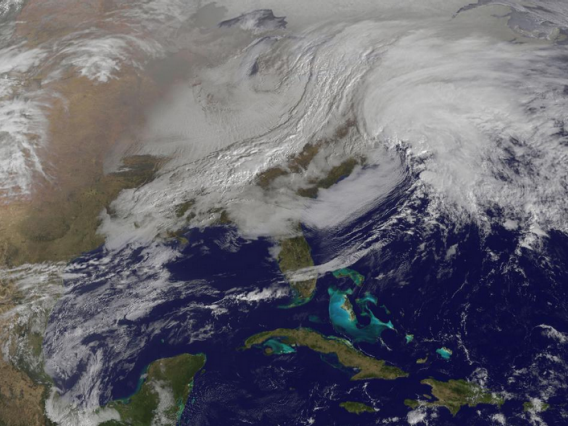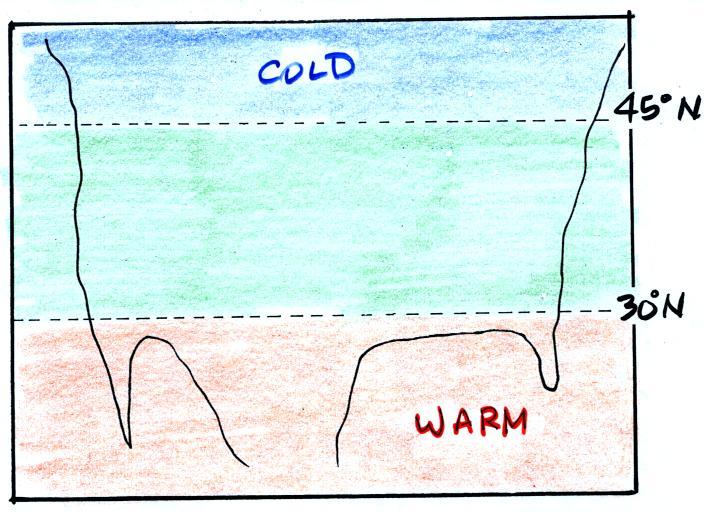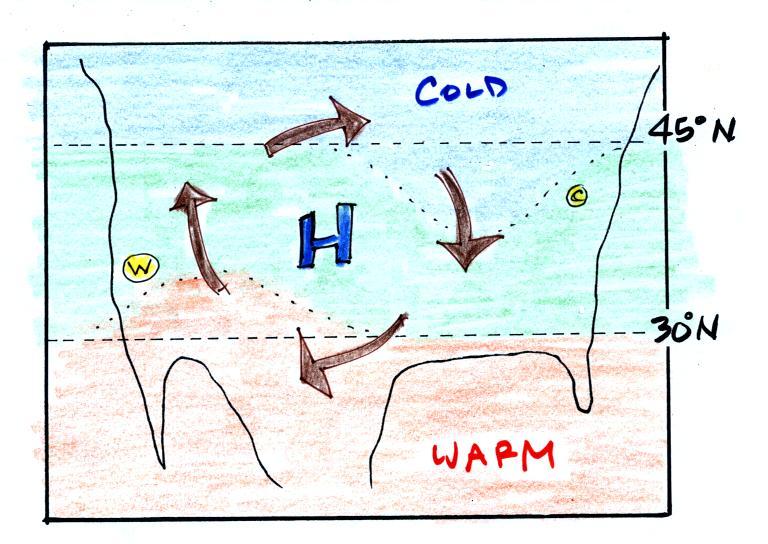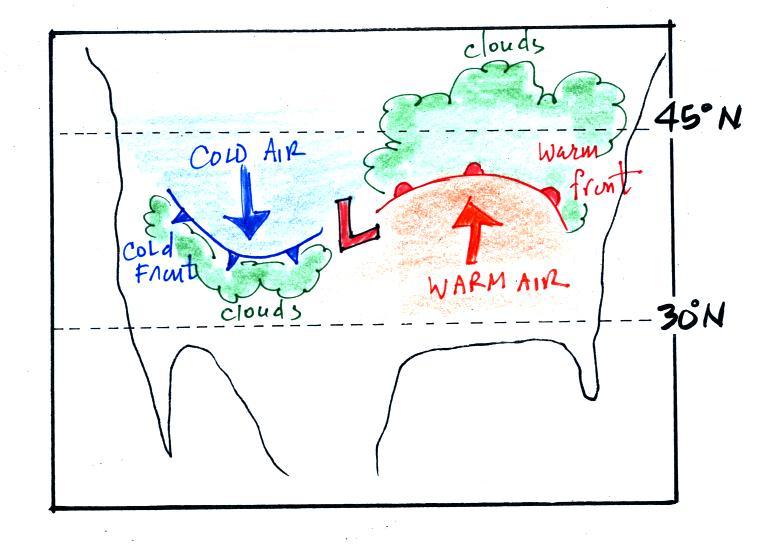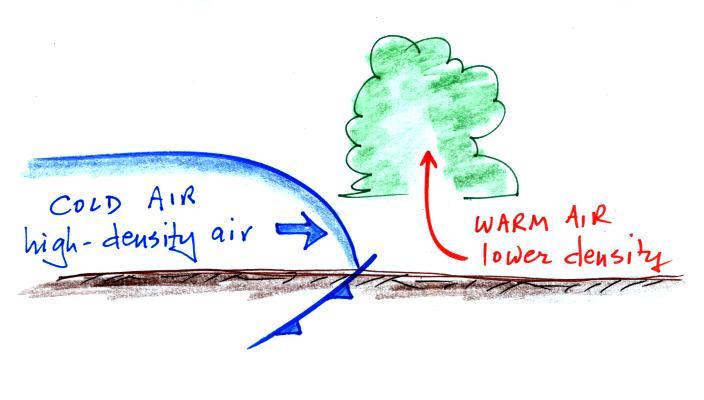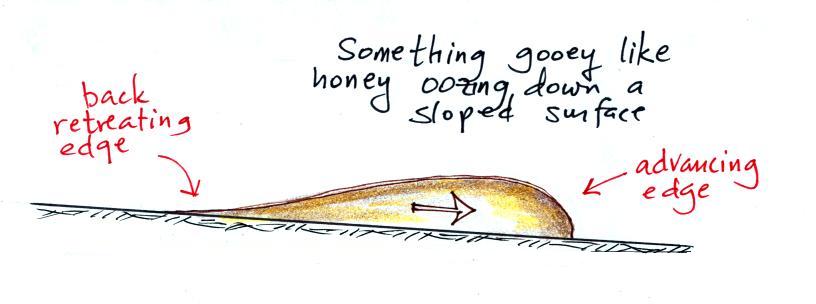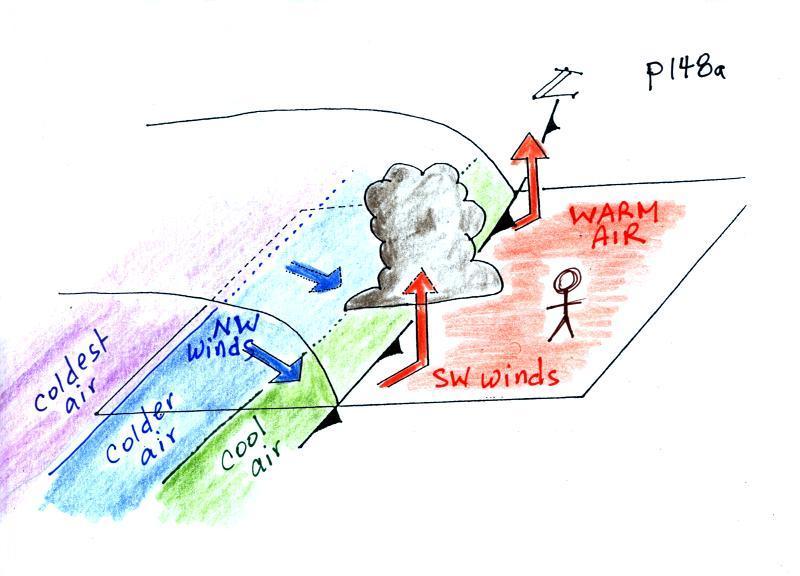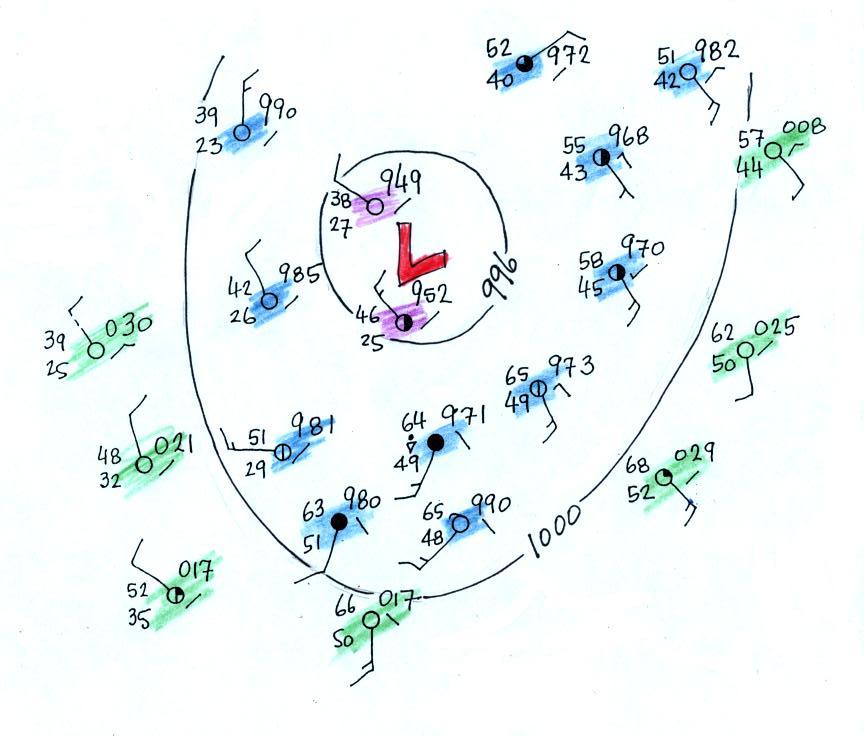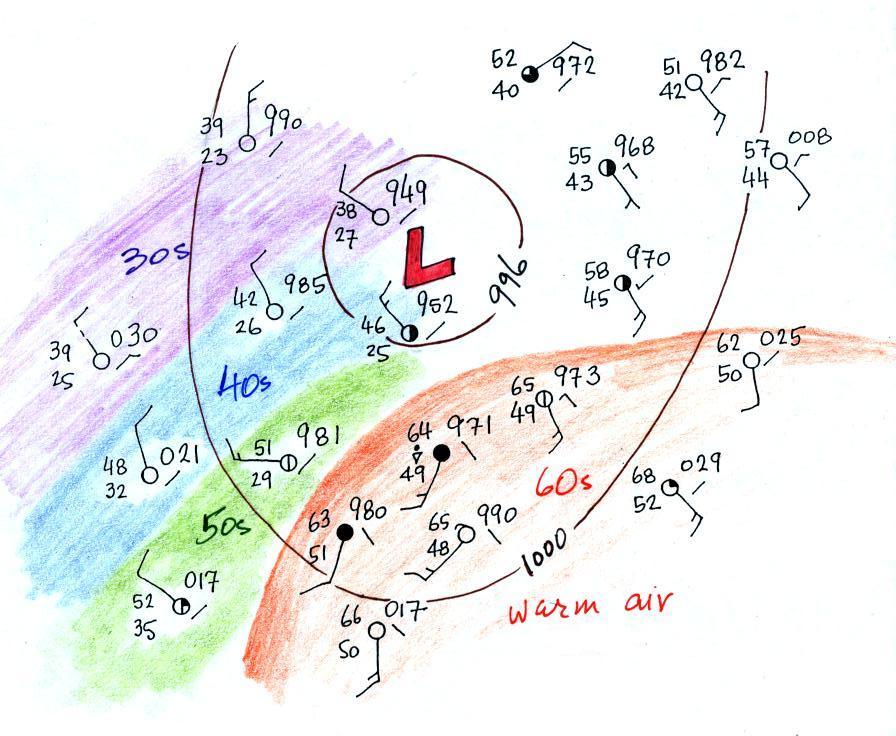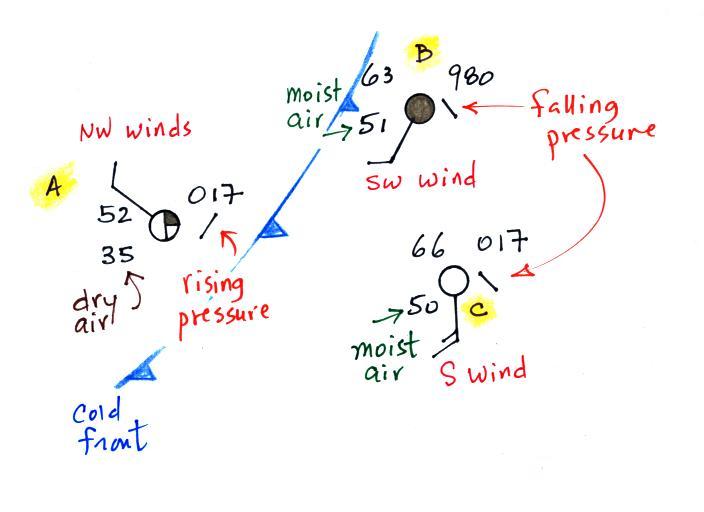Friday Feb. 8, 2013.
click here to download
today's notes in a more printer friendly format
With unsettled weather approaching I opted for a moody song choice
for class today "Undone in
Sorrow (live)" by Crooked Still. Here's a second shorter
version with better audio.
The radon 1S1P reports
have been graded and were returned in class today. The
average score was 7.8 out of 10.
There is an Optional
Assignment due at the beginning of class next Monday.
Here's a satellite picture of the two storms that will merge
and dump up to 2 feet of snow (maybe more) on parts of New England
today and tomorrow. Pressures in the center of the storm may
drop into the 970 millibars range which could produce hurricane
force winds along the coast.
NOAA Goes-13 satellite photograph (source)
For the latest information I would recommend either the AccuWeather or the Weather Channel sites. The
animated forecasts shown in class were from the National Weather
Service and are available here.
Back to surface weather maps.
On Wednesday we saw how drawing pressure contours, isobars, can
locate centers of high and low pressure. Winds spin in a
counterclockwise direction and spiral inward around low
pressure. The converging winds cause air to rise, expand,
and cool. If the air is moist and there is sufficient
cooling clouds can form. Pretty much the opposite is true
with high pressure (clockwise winds spiral outward, divergence
causes sinking air and clear skies).
The spacing of the contour lines tells you something about wind
speed. Closely spaced contours, a strong pressure gradient,
create strong winds. Widely spaced contours, a weak pressure
gradient, produce slower winds.
Today we'll see that once the winds start to blow they can affect
and change the temperature pattern. The figure
below shows the temperature pattern you would expect to see if the
wind wasn't blowing at all or if the wind was just blowing
straight from west to east. The bands of different
temperature are aligned parallel to the lines of latitude.
Temperature changes from south to north but not from west to
east.
This picture gets a little more interesting if you put
centers of high or low pressure in the middle.
In the case of high pressure,
the clockwise spinning winds move warm air to the north on the
western side of the High. The front edge of this northward
moving air is shown with a dotted line (at Pt. W) in the picture
above. Cold air moves toward the south on the eastern side
of the High (another dotted line at Pt. C). The diverging
winds also move the warm and cold air away from the center of
the High. Now you would experience a change in temperature
if you traveled from west to east across the center of the
picture.
The transition from warm to cold along the boundaries (Pts. W
and C) is spread out over a fairly long distance and is
gradual. This is because the winds around high pressure
blow outward away from the center of high pressure. There
is also some mixing of the different temperature air along the
boundaries.
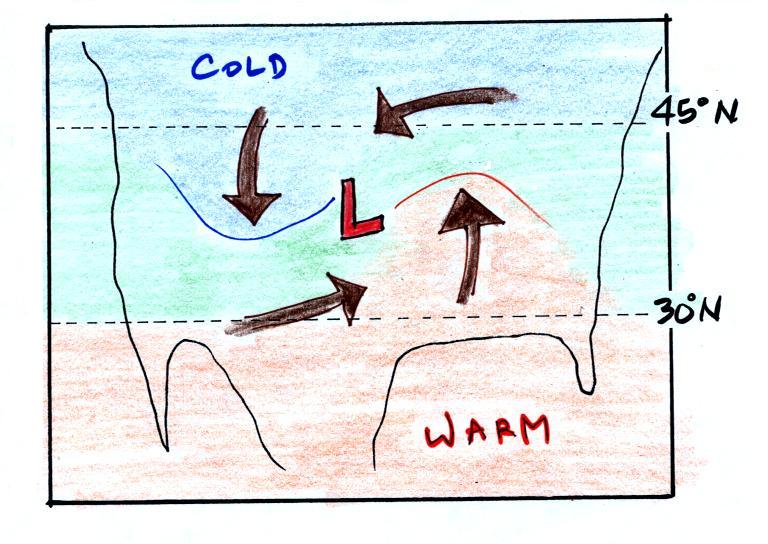
The converging winds in the case of low pressure will move the
air masses of different temperature in toward the center of low
pressure. The transition zone between different temperature
air gets squeezed and compressed. The change from warm to
cold occurs in a shorter distance and is more abrupt. Solid
lines have been used to delineate the boundaries above. These
sharper and more abrupt boundaries between are called fronts.
A cold front is drawn at the front edge of the southward moving
mass of cold air on the west side of the Low. Cold fronts
are generally drawn in blue on a surface weather map. The
small triangular symbols on the side of the front identify it as a
cold front and show what direction it is moving. The fronts
are like spokes on a wheel. The "spokes" will spin
counterclockwise around the low pressure center (the axle).
A warm front (drawn in red with half circle symbols) is shown
on the right hand side of the map at front edge of the northward
moving mass of. A warm front is usually drawn in red and has
half circles on one side of the front to identify it and show its
direction of motion.
Both types of fronts cause rising air motions. Fronts are
another way of causing air to rise. Rising air expands and
cools. If the air is moist and cools enough, clouds can
form.
The storm system shown in the picture above (the Low together with
the fronts) is referred to a middle latitude storm or an
extra-tropical cyclone. Extra-tropical means outside the
tropics, cyclone means winds spinning around low pressure
(tornadoes are sometimes called cyclones, so are
hurricanes). These storms form at middle latitudes because
that is where air masses coming from the polar regions to the
north and the more tropical regions to the south can collide.
Large storms that form in the tropics (where this mostly just warm
air) are called tropical cyclones or, in our part of the world,
hurricanes.
We'll be looking in more detail at the
structure of warm and cold fronts and the weather changes that
can occur as they approach and pass through. We'll also
look at how you might go about locating fronts on a surface
weather map.
A vertical slice through a cold front is shown below at
left. Pay particular attention to the shape of the
advancing edge of the cold air mass. Friction with the
ground causes the front edge to "bunch up" and gives it the
blunt shape it has. You'd see something similar if you
were to pour something thick and gooey on an inclined surface
and watch it roll downhill.
The cold dense air mass behind
a cold front moves into a region occupied by warm air.
The warm air has lower density and will be displaced by the
cold air mass. In some ways its analogous to a big heavy
Cadillac plowing into a bunch of Volkswagens.
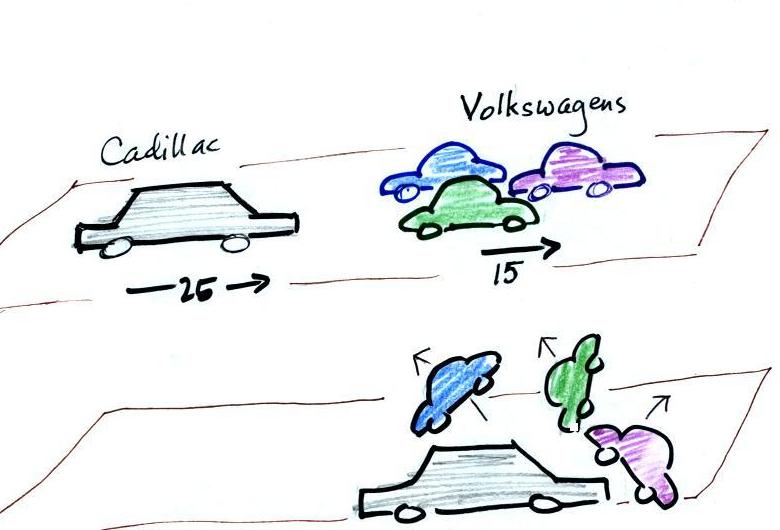
The VWs would be thrown up into the air by the Cadillac.
A sort of 3-dimensional cross-sectional view of a
cold front is shown below (we've jumped to p. 148a in the
photocopied ClassNotes)
The person in the figure is positioned ahead of an approaching
cold front. It might be the day before the front
actually passes through.
The warm air mass ahead of the front has just been sitting
there and temperatures are pretty uniform throughout.
The air behind the front might have originated in
Canada. It might have started out very cold but as it
travels to a place like Arizona it can change (warm)
considerably. The air right behind the front will have
traveled the furthest and warmed the most. That's the
reason for the cool, cold, and colder temperature gradient
behind the front.
Here are some of the specific weather changes that might
precede and follow a cold front
Weather
variable
|
Behind
|
Passing
|
Ahead
|
Temperature
|
cool, cold,
colder*
|
|
warm
|
Dew
Point
|
usually much drier
|
|
may be moist (though
that is often
not the case here in the desert southwest)
|
Winds
|
northwest
|
gusty winds (dusty)
|
from the southwest
|
Clouds,
Weather
|
clearing
|
rain clouds,
thunderstorms in
narrow band along the front
(if the warm air mass is moist)
|
might see some high
clouds
|
Pressure
|
rising
|
reaches a minimum
|
falling
|
* the
coldest air might follow passage of a cold front by a day or
two. Nighttime temperatures often plummet in the cold
dry air behind a cold front.
A temperature drop is probably the most obvious change
associated with a cold front. Here is southern Arizona,
gusty winds and a wind shift are also often noticeable when a
cold front passes.
The pressure changes that precede and follow a cold front are
not something we would observe or feel but are very useful
when trying to locate a front on a weather map.
Here are the links to two short video segments of cold front
passing through Tucson. I showed them earlier in the
semester and didn't show them again in class today. The
first was a time lapse movie of a cold front that passed through
Tucson on Easter Sunday, April 4, in 1999. It actually
snowed for a short time during the passage of the cold
front. Click here
to see the cold front video (it may take a minute or two to
transfer the data from the server computer in the Atmospheric
Sciences Dept., be patient). Remember the video shows a time
lapse movie of the frontal passage. The front seems to
race through Tucson in the video, it wasn't moving as fast as the
video might lead you to believe. Cold fronts typically move
15 to 25 MPH.
The 2nd
video was another cold front passage that occurred last
spring on February 12, 2012.
In the next figure we started with some weather
data plotted on a surface map using the station model
notation. We'll try to make a little more sense of this
data.
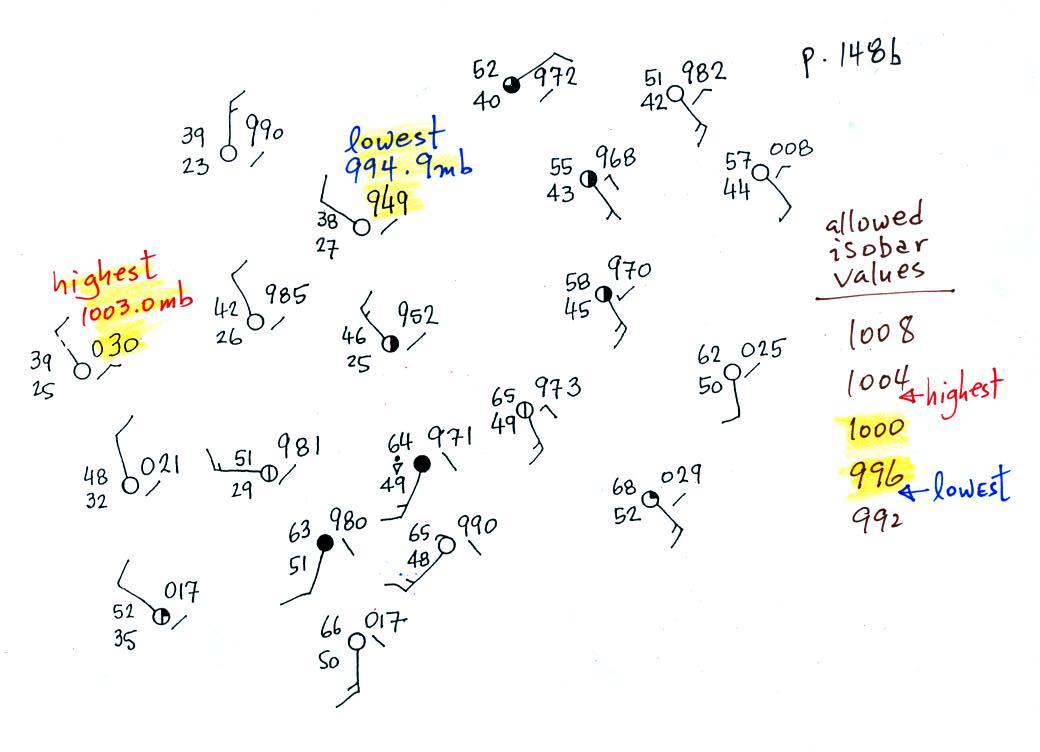
Before trying to locate a cold front, we needed to draw in a
few isobars and map out the pressure pattern. In some
respects fronts are like spokes on a wheel - they rotate
counterclockwise around centers of low pressure. It
makes sense to first determine the location of the low
pressure center.
Isobars are drawn at 4 mb increments above and below a
starting value of 1000 mb. Some of the allowed values
are shown on the right side of the figure (992, 996, 1000,
1004, 1008 etc). The highest pressure on the map is
1003.0 mb, the lowest is 994.9 mb. You must choose from
the allowed list of isobar values and pick only the values
that fall between the high and low pressure values on the
map. Thus we need to draw in 996 mb and 1000 mb
isobars.
In the figure below stations with pressures lower than 996 mb
have been colored in purple. These will be enclosed by
the 996 mb contour. Pressures between 996 and 1000 mb
have been colored blue. These stations will lie outside
the 996 mb contour but inside the 1000 mb isobar.
Finally stations with pressures greater than 1000 mb have been
colored green. The 1000 mb isobar will separate the blue
stations from the green stations.
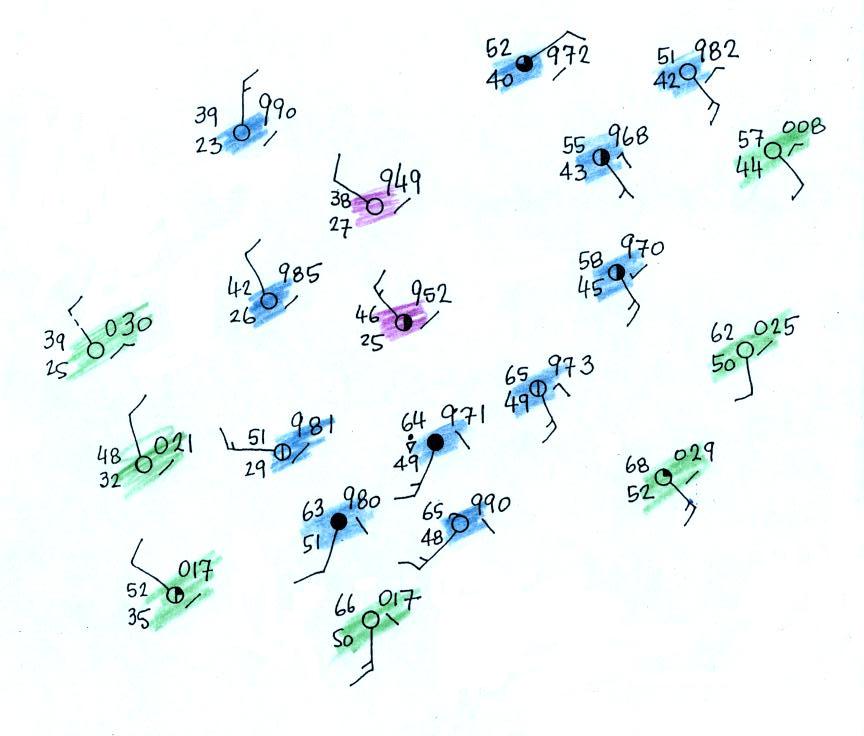
The next step was to try to
locate the warm air mass in the picture. We've left the
isobars in the figure below but now have used colors to
identify air masses with different temperatures.
Temperatures are in the 60s in the lower right
portion of the map; this area has been circled in
orange. Cooler air to the west of the Low pressure
center has also been identified. Based on just the
temperatures just should have a pretty good idea where a cold
front would be found.
The cold front on the map seems to be properly
positioned. Note
how the cold front is positioned at the leading edge of the
cold air mass, not necessarily in front of the coldest air in
the cold air mass.
3
of
the
stations
from
the
bottom
portion
of
the map have been redrawn below.
The air ahead of the front (Pts. B & C) is warm, moist,
has winds blowing from the S or SW, and the pressure is
falling. These are all things you would expect to find
ahead of a cold front.
Overcast skies are found at Pt. B. very near the front.
The air behind the front at Pt. A is colder, drier, winds are
blowing from the NW, and the pressure is rising.
Next Monday we'll look at warm fronts and also at upper level
charts that depict conditions at various levels above the ground.
